2015 AUDI S3 SEDAN airbag off
[x] Cancel search: airbag offPage 166 of 282
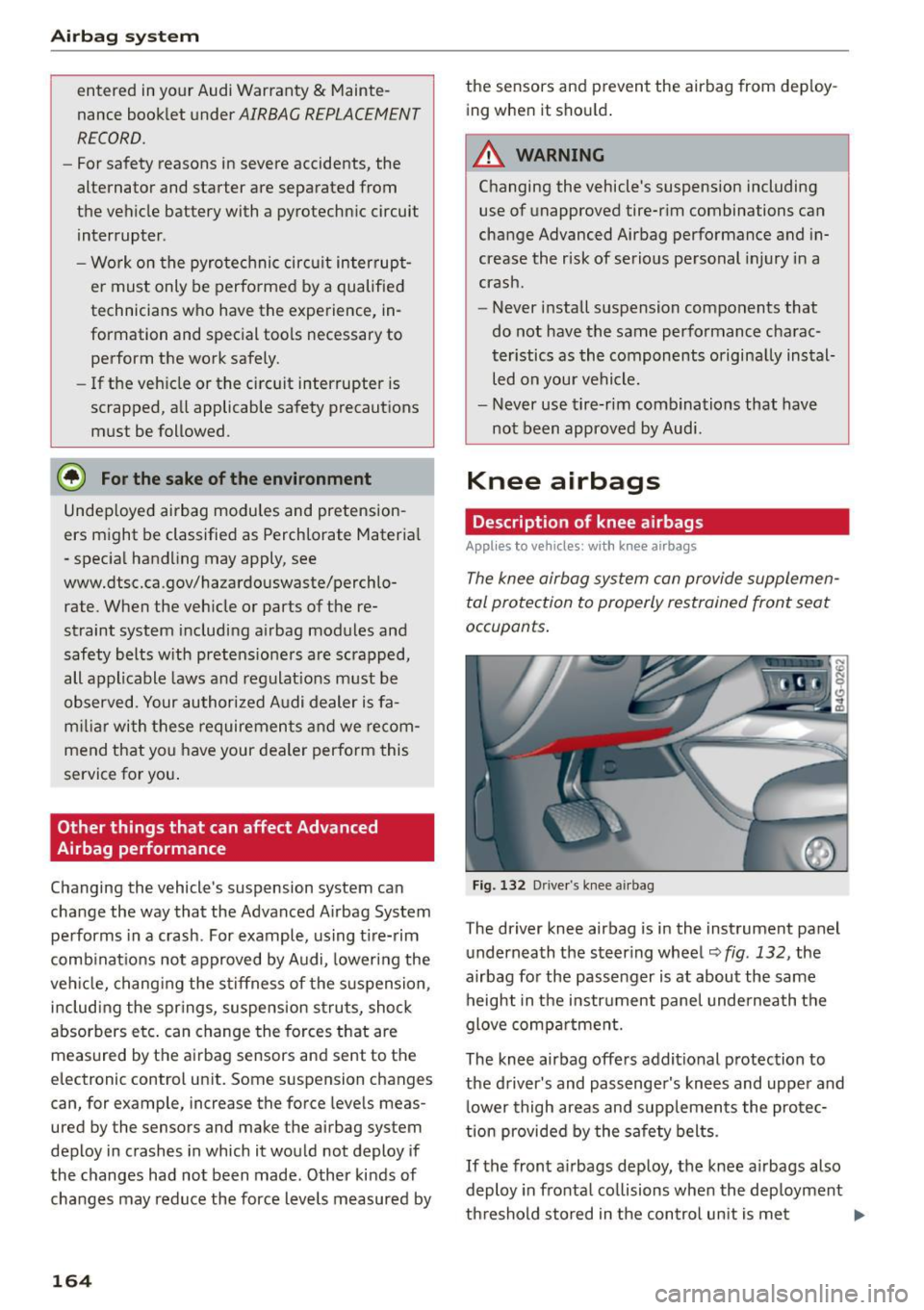
Airb ag syst em
entered in your Audi Warranty & Mainte
nance booklet under
AIRBAG REPLACEMENT
RECORD.
- For safety reasons in severe accidents, the
alternator and starter are separated from
the vehicle battery with a pyrotechnic circuit interrupter .
- Work on the pyrotechnic circ uit inter rupt
er must only be performed by a qualified
technicians w ho have the experience, in
formation and special tools necessary to perform the work safely.
- If the veh icle or the circuit interrupter is
scrapped, a ll applicable safety precautions
must be followed.
@ For the sake of the environment
Undep loyed airbag modu les and pretension
ers might be classified as Perchlorate Materia l
- specia l hand ling may apply, see
www.dtsc.ca.gov/hazardouswaste/perchlo rate. W hen the veh icle or parts of the re
straint system including a irbag modules and
safety belts with prete nsioners are scrapped ,
all applicable laws and regulat ions must be
observed. Your authorized A udi dealer is fa
m iliar with the se requirements a nd we recom
mend that you have your dealer perform this
service for yo u.
Other things that can affect Advanced
Airbag performance
Changing the vehicle's suspension system ca n
change the way that the Advanced A irbag System
performs in a crash. For example, using t ire- rim
combinat ions not approved by Audi, lower ing the
ve hicl e, chang ing the stiffness of the suspension,
includ ing the spr ings, suspension s truts, shoc k
absorbers etc. can change the forces that are
measured by the a irbag sensors and sent to the
e lectronic control unit. Some suspension changes
can, for example, increase the force levels meas
ured by the sensors and make the a irbag system
deploy in c rashes in which it wou ld not deploy if
the changes had not been made. Other ki nds of
changes may reduce the force levels measured by
164
the sensors and p revent the airbag from dep loy
ing when it shou ld .
A WARNING
Changing the vehicle's suspension including
use of unapproved tire-rim combinations can
change Advanced Airbag performance and in
crease the risk of serious personal injury in a
crash.
- Never install suspension components that
do not have the same performance charac
ter istics as the components origina lly instal
led on you r vehicle.
- Never use tire-rim combinations that have
not been approved by Audi.
Knee airbags
Description of knee airbag s
Applies to vehicles: with knee airbags
The knee airbag system can provide supplemen
tal protection to properly restrained front seat
occupants .
Fig. 132 Driver 's knee a irbag
The driver knee airbag is i n the instrument panel
u nderneath the steer ing wheel ~
fig. 132 , the
airbag fo r the passenger is at abou t the same
height in the i nstr ument panel underneath the
glove comp artment.
The knee airbag offers additional protection to
the d river's and passenge r's kn ees and uppe r and
lower thigh areas and supplements the protec
tion provided by the safety belts.
If the front a irbags deploy, the knee a irbags also
deploy in fronta l co llisions when the dep loyment
th reshold stored in the con trol un it is met
II>-
Page 167 of 282
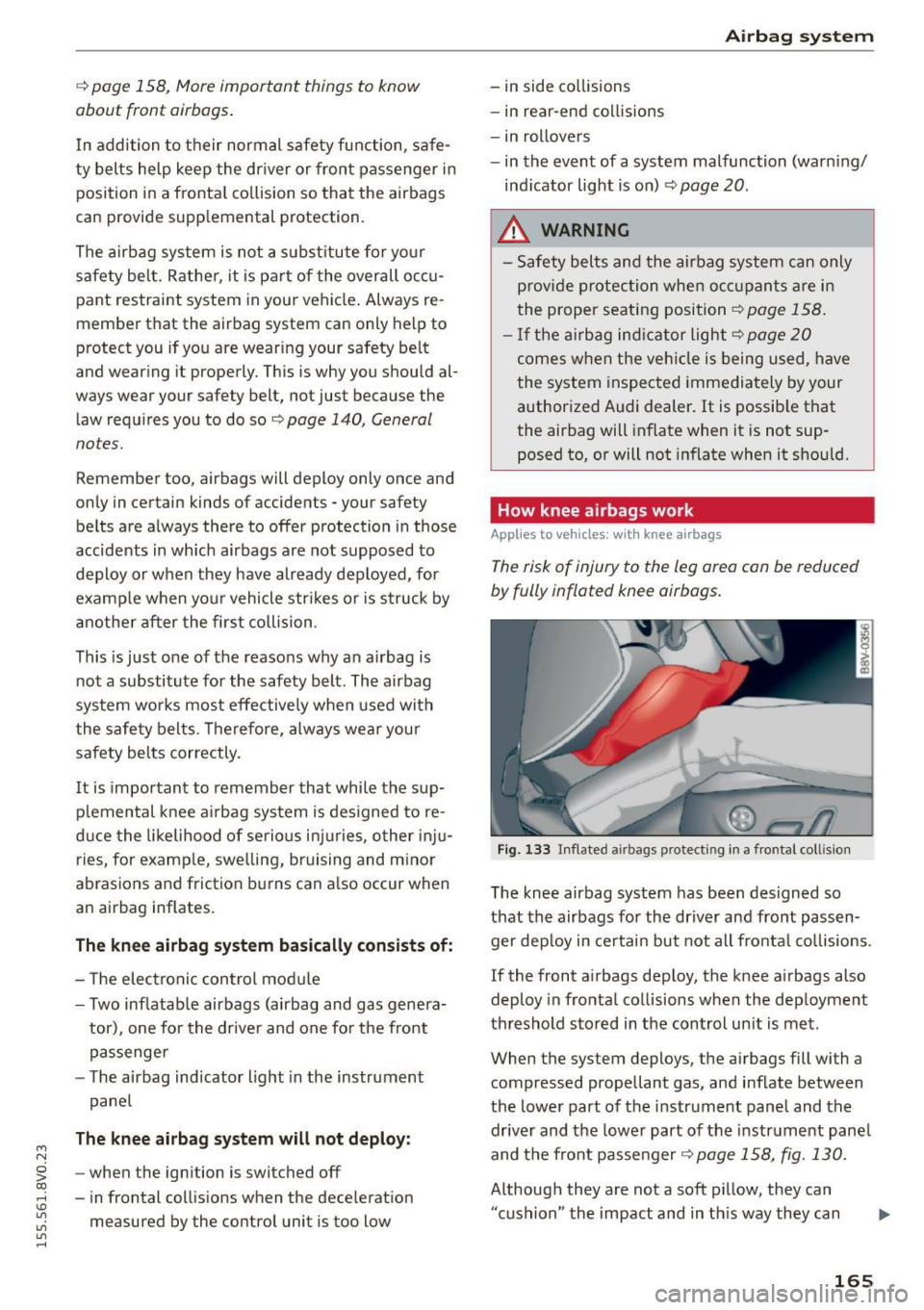
....,
N
0 > co
rl I.O
"'
"'
"'
rl
¢ page 158, More impor tant things to know
about front airbags .
In addition to their normal safety function, safe
ty belts help keep the driver or front passenger in position in a fronta l co llision so that the airbags
can provide supp lemental protection.
The airbag system is not a s ubst itute for yo ur
safety belt. Rather, it is part of the overall occu pant restraint system in your vehicle . Always re
member that the airbag system can only help to
protect you if you are wearing your safety belt
and wearing it properly. This is why you should al
ways wear your safety belt, not just because the law requires you to do so~
page 140, General
notes.
Remember too, airbags will deploy only once and
only in certain kinds of accidents -your safety
be lts are a lways there to offer protection in those
accidents in which airbags are not supposed to
deploy or when they have already deployed, for
examp le when yo ur vehicle str ikes or is struck by
anothe r after the first collision .
This is just one of the reasons why an a irbag is
not a substitute for the safety belt . The airbag
sys tem works most effective ly when used with
the safety belts. Therefore, always wear your
safety bel ts correctly .
It is important to remember that whi le the sup
p lemental knee a irbag sys tem is designed to re
d uce the likelihood of serious i njur ies , o ther inj u
ries, for examp le, swe lling, bruising and m inor
abrasions and friction b urns can a lso occur when
an airbag inf lates.
The kne e airbag system basically consist s of:
- T he elec tronic control mod ule
- Two inflatab le airbags (airbag and gas genera-
tor), one for the drive r and one fo r the front
passenge r
- T he airbag ind icator light in the instrument
pane l
The knee airb ag system will not deploy:
- when the ign it ion is swi tched off
- in frontal collis ions when the dece lerat ion
measured by the control unit is too low
Ai rb ag system
- in side co llisions
- in rear-end col lisions
- in rollove rs
- in the event of a system malfunction (war ning/
ind icator light is on) ¢
page 20.
,&. WARNING
-Safety belts and the airbag system can only
prov ide protection when oc cupan ts are in
the proper seating position~
page 158 .
- If th e ai rbag ind icator light 9 page 20
comes when the veh icle is being used, have
the system inspected immediately by your
authorized Audi dealer .
It is possible that
the airbag will inflate when it is not sup
posed to, or will not inflate when it should.
How knee airbags work
Applies to vehicles: wit h knee airbags
The risk of injury to the leg area can be reduced
by fully inflated knee airbags .
Fig . 1 33 Inflated a irbags p rotect ing in a fro nta l co llision
The knee airbag system has been designed so
that the airbags for the driver and front passen
ger dep loy in certai n but not all fronta l collisions.
If the front ai rbags dep loy, the knee a irbags also
deploy in frontal co llisions when the deployment
threshold stored in the control un it is met .
When the system deploys, the airbags fill with a compressed propellant gas, and inflate between
the lowe r part of the i nstr ument panel and the
driver and the lower part of the instrument pane l
and the front passenger ¢
page 158, fig. 130.
Although they are not a soft pillow , they can
" cushion " the impact and in th is way they can
165
Page 169 of 282
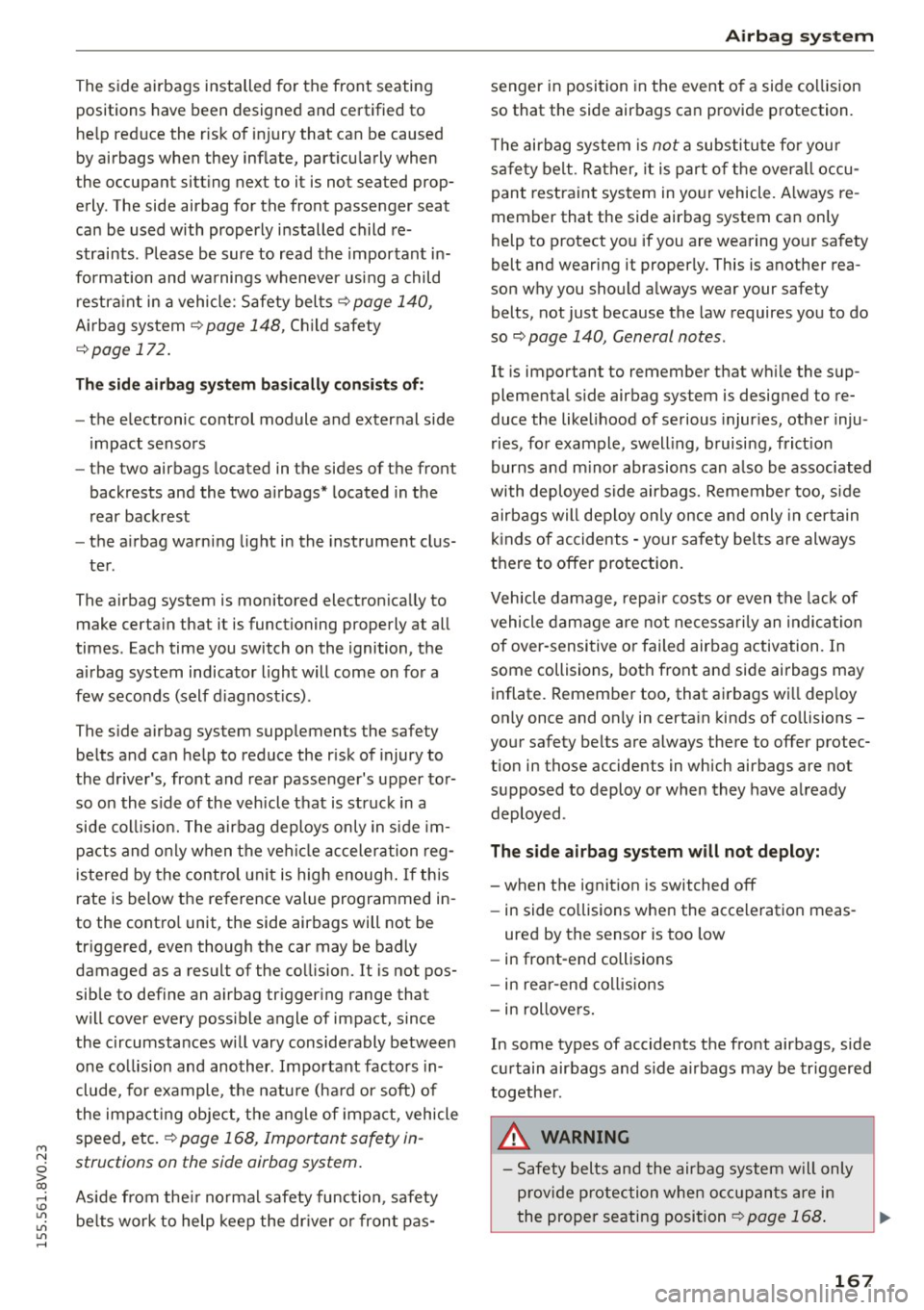
M N
0 > co ,...., \!) 1.1'1
1.1'1
1.1'1
,....,
The side airbags installed for the front seating
positions have been designed and certified to
he lp reduce the risk of in jury that can be caused
by airbags when they inflate, part icu larly when
the occupant sitt ing next to it is not seated prop
erly . The side airbag for the front passenger seat
can be used with properly i nstalled child re
straints . Pl ease be sure to read the important in
fo rmation and wa rnings whenever using a child
r estra int in a vehicle: Safety belts
q page 140,
Airbag system qpage 148, Child safety
qpage 172.
The s ide airba g syste m ba sicall y co nsis ts of :
-the e lectronic control module and external side
i mpact sensors
- the two airbags located in the sides of the front
backrests and the two a irbags* located in the
rear backrest
- the a irbag warning light in the inst rument clus-
te r.
The airbag system is monitored electron ica lly to
make certa in that it is functioning properly at all
times. Each time you switch on the ignition, the
ai rbag system indicator light will come on for a
few seconds (self d iagnost ics) .
The s ide airbag system supplements the safety
belts and can help to reduce the r isk of injury to
the dr iver's, front and rear passenger's upper to r
so on the side of the veh icle that is struc k in a
side col lision. The airbag deploys only in s ide im
pacts and o nly when the vehi cle acceleration reg
is tered by the control unit is high enough . If this
rate is below t he reference value programmed in
to the contro l unit, the side airbags will not be
tr iggered, even though the car may be badly
damaged as a result of the co llision. It is not pos
sible to define an airbag tr igger ing range that
will cover every poss ible angle of impact, since
the circumstances wi ll vary considerably between
one co llision and another . Important factors in
clude, for example, the nature (ha rd or soft) of
the impa cting object, the angle of impact, vehicle
speed, etc.
q page 168, Important safety in
structions on the side airbag system.
Aside from the ir normal safety func tion, safety
be lts work to help keep the dr iver or front pas -
Airbag syste m
senger in posi tion in the event o f a side co llision
so that the side airbags ca n provide protection.
T he airbag system is
not a substi tute for you r
sa fety belt . Rather, it is part o f the overa ll occu
pant restrain t system in yo ur vehicle. A lways re
member that the side airbag system ca n only
help to protect yo u if you are wearing your safety
belt and wearing it properly. This is another rea
son why you should a lways wear your safety
belts, not just because the law requires you to do
so
q page 140, General notes .
It is important to remember that wh ile the sup
plemental side airbag system is designed to re
duce the like lihood of serious injur ies, othe r inju
ries, fo r example, swell ing, bruising, frict ion
burns and m inor abrasions can a lso be associated
with deployed side airbags. Remember too, s ide
airbags will deploy only once and only in cer tain
ki nds of accidents - yo ur safe ty belts are always
t h ere to offer protection.
Vehicle damage , repair costs o r even the lack of
vehicle dam age are no t necessari ly an indica tion
of over-sensitive o r failed airbag activation. In
some collisions, bo th front and side airbags may
inflate. Remember too, that ai rbags wi ll dep loy
on ly once and on ly in certa in kinds of co llisions -
your safety belts are always there to offer protec
t ion in those accidents in which airbags are not
supposed to deploy or when they have already
deployed .
The side airbag system will not deploy:
- when the ignit ion is switched off
- in side co llisions when the acceleration meas -
ured by the senso r is too low
- in front-end collisions
- in re ar-en d co llisions
- in rollove rs.
In some types of accidents t he front airbags, side
cu rtain airbags and s ide a irbags may be tr iggered
togethe r.
&_ WARNING
- Safety belts and the airbag system will only
p rovide p rotec tion when o ccupants are i n
the proper seating position
q page 1 68 .
167
Page 172 of 282
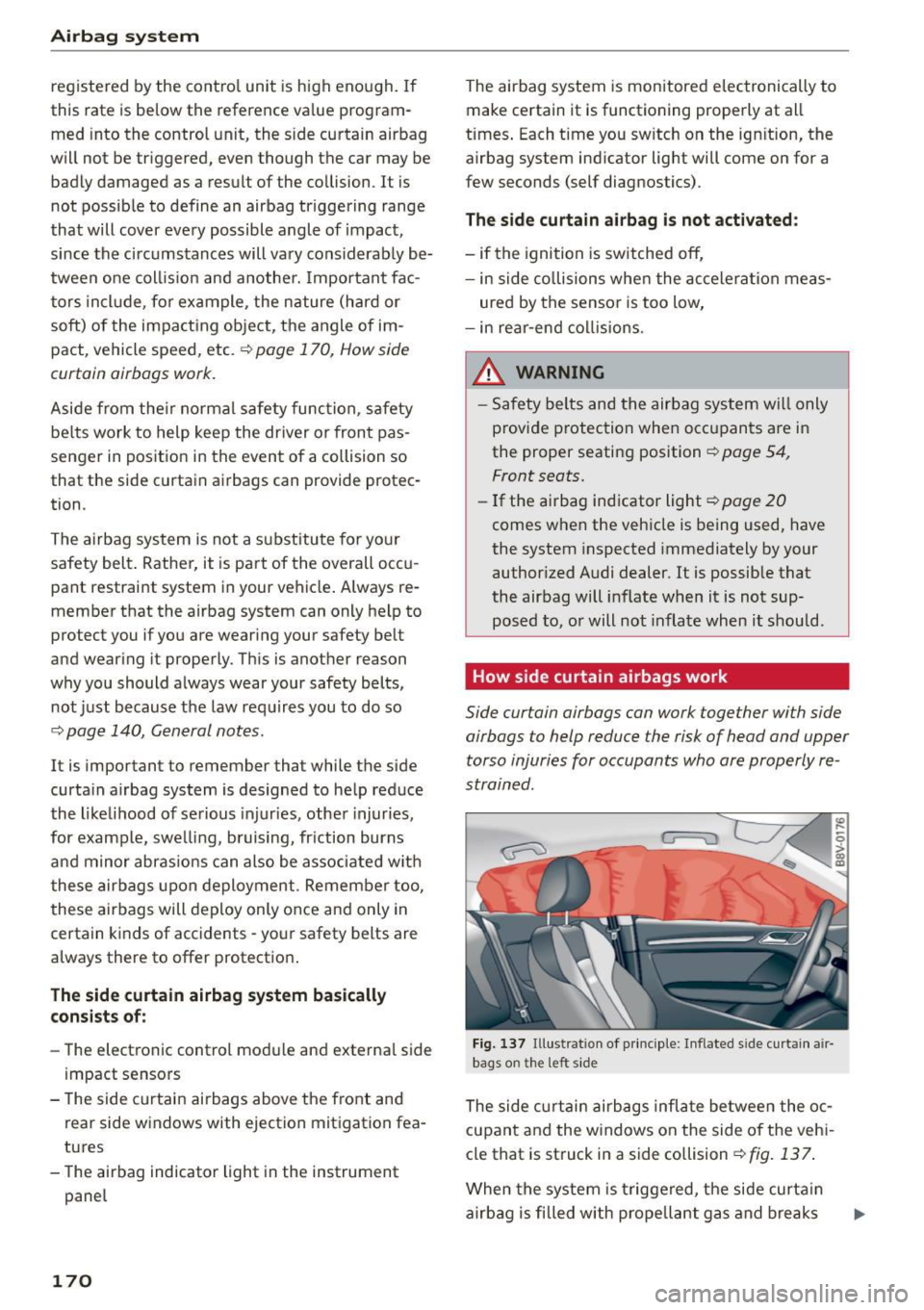
Airb ag syst em
registered by the cont ro l unit is high enough. If
this rate is below the reference va lue program
med into the control unit, the s ide curtain airbag
will not be triggered, even though the car may be
badly damaged as a result of the collision .
It is
not possib le to define an airbag triggering range
that will cover every possible angle of impact ,
since the circumstances will vary considerab ly be
tween one col lis ion and another. Important fac
tors include , for example , the nature (hard or
soft) of the impacting object, the angle of im
pact , vehicle speed, etc.
9 page 170, How side
curtain airbags work.
Aside from the ir normal safety function , safety
be lts work to help keep the driver or front pas
senger in position in the event of a collision so
that the side curtain airbags can provide protec
tion .
The airbag system is not a substitute for your
safety belt . Rather, it is part of the overall occ u
pant restraint system in your vehicle . Always re
member that the airbag system can only he lp to
protect you if you are wearing your safety belt
and wearing it properly . Th is is another reason
why you should a lways wear your safety belts,
not just because t he law requires you to do so
9 page 140, General notes.
It is important to remember that while the side
curta in a irbag system is designed to help reduce
the likelihood of serious injur ies, other injur ies,
for example, swe lling, bruising, fr iction burns
and minor abras ions can also be associated w it h
these airbags upon deployment . Remember too,
these airbags will deploy only once and only in
certain kinds of accidents -your safety belts are
always there to offer protection .
The side curt ain airbag sy stem basically
consist s of:
- The electronic control modu le and externa l side
impact sensors
- The side c urtain airbags above the fro nt and
rear side w indows with ejection mit igation fea
tures
- The airbag indicator light in the instrument
panel
170
The airbag system is monitored electronically to
make certain it is functioning properly at all
times . Each time you sw itch on the ign ition, the
airbag system ind icator light will come on for a
few seconds (self diagnostics).
The side curtain airbag i s not acti vat ed :
- if the ign ition is switched off,
- in side collisions whe n the accelera tion meas-
ured by the sensor is too low,
- in rear-end col lis ions .
.&_ WARNING
-Safety belts and the airbag system wi ll only
provide protection when occupants are in
the proper seating position
9 page 54,
Front seats.
- If the airbag indicator light~ page 20
comes when the vehicle is being used, have
the system inspected immediately by your
author ized Audi dealer.
It is possible that
the airbag will inflate when it is not sup
posed to, or will not infla te when it should.
How side curtain airbags work
Side curtain airbags can work together with side
airbags to help reduce the risk of head and upper
torso injuries for occupants who ore properly re
strained .
Fig. 137 Illust rat ion of prin cip le: I nflated s ide curtain a ir
bag s on t he le ft s ide
The side curtai n airbags infla te be tween the oc
cupant and the w indows on the side of the veh i
cle that is st ruck in a side collision~
fig. 137.
When the system is triggered, the side curta in
airbag is filled with prope llant gas and breaks
Page 175 of 282
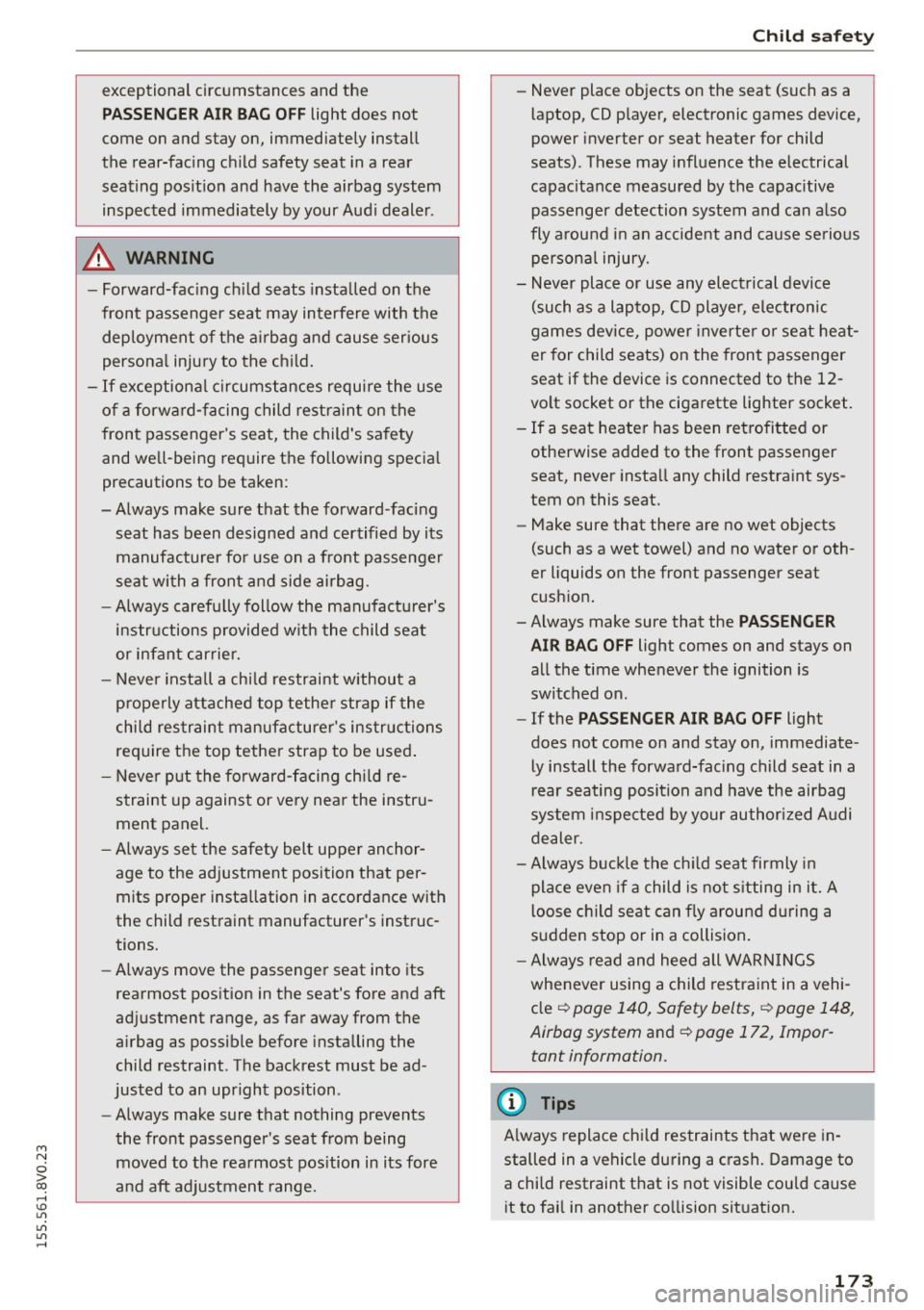
M N
0 > co ,...., \!) 1.1'1
1.1'1
1.1'1
,....,
exceptional circumstances and the
PASSENGER AIR BAG OFF light does not
come on and stay on, immediately install
the rear-facing child safety seat in a rear
seating position and have the airbag system
inspected immediately by your Audi dealer .
A WARNING
-Forward-facing child seats installed on the
front passenger seat may interfere with the deployment of the airbag and cause serious
personal injury to the child.
-If exceptional circumstances require the use
of a forward-facing child restraint on the
front passenger's seat, the child's safety
and well-being require the following special
precautions to be taken:
-Always make sure that the forward-facing seat has been designed and certified by its manufacturer for use on a front passenger
seat with a front and side airbag.
-Always carefully follow the manufacturer's
instructions provided with the child seat
or infant carrier.
- Never install a child restraint without a
properly attached top tether strap if the
child restraint manufacturer's instructions require the top tether strap to be used.
- Never put the forward-facing child re
straint up against or very near the instru
ment panel.
- Always set the safety belt upper anchor
age to the adjustment position that per
mits proper installation in accordance with
the child restraint manufacturer's instruc
tions.
- Always move the passenger seat into its
rearmost position in the seat's fore and aft
adjustment range, as far away from the
airbag as possible before installing the
child restraint . The backrest must be ad
justed to an upright position .
- Always make sure that nothing prevents
the front passenger's seat from being moved to the rearmost position in its fore
and aft adjustment range.
Child safety
-Never place objects on the seat (such as a
laptop, CD player, electronic games device,
power inverter or seat heater for child
seats) . These may influence the electrical
capacitance measured by the capacitive
passenger detection system and can also
fly around in an accident and cause serious
personal injury.
- Never place or use any electrical device
(such as a laptop, CD player, electronic
games device, power inverter or seat heat
er for child seats) on the front passenger
seat if the device is connected to the 12-
volt socket or the cigarette lighter socket.
- If a seat heater has been retrofitted or
otherwise added to the front passenger
seat, never install any child restraint sys
tem on this seat.
- Make sure that there are no wet objects
(such as a wet towel) and no water or oth
er liquids on the front passenger seat
cushion.
- Always make sure that the
PASSENGER
AIR BAG OFF
light comes on and stays on
all the time whenever the ignition is
switched on.
- If the
PASSENGER AIR BAG OFF light
does not come on and stay on, immediate
ly install the forward-facing child seat in a
rear seating position and have the airbag
system inspected by your authorized Audi
dealer.
- Always buckle the child seat firmly in
place even if a child is not sitting in it. A
loose child seat can fly around during a
sudden stop or in a collision.
- Always read and heed all WARNINGS
whenever using a child restraint in a vehi
cle
¢ page 140, Safety belts, ¢ page 148,
Airbag system
and ¢ page 172, Impor
tant information.
(D Tips
Always replace child restraints that were in
stalled in a vehicle during a crash. Damage to
a child restraint that is not visible could cause
it to fail in another collision situation.
173
Page 176 of 282
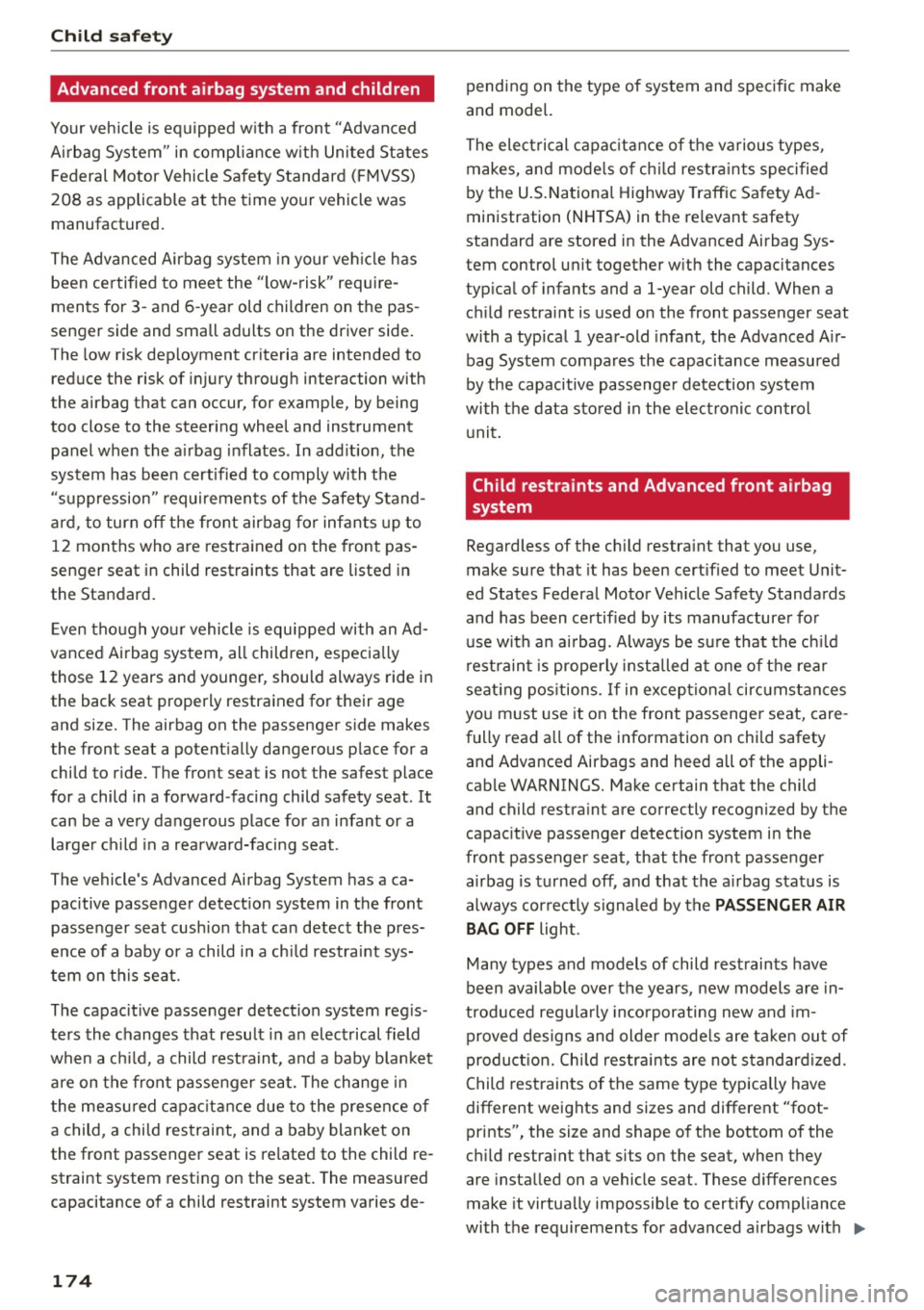
Child safety
Advanced front airbag system and children
Your vehicle is equipped with a front "Advanced
Airbag System" in compliance with United States Federal Motor Vehicle Safety Standard (FMVSS)
208 as applicable at the time your vehicle was
manufactured.
The Advanced Airbag system in your vehicle has
been certified to meet the "low-risk" require
ments for 3- and 6-year old children on the pas
senger side and small adults on the driver side.
The low risk deployment criteria are intended to
reduce the risk of injury through interaction with
the airbag that can occur, for example, by being
too close to the steering wheel and instrument panel when the airbag inflates. In addition, the
system has been certified to comply with the
"suppression " requirements of the Safety Stand
ard, to turn off the front airbag for infants up to
12 months who are restrained on the front pas
senger seat in child restraints that are listed in
the Standard.
Even though your vehicle is equipped with an Ad
vanced Airbag system, all children, especially
those 12 years and younger, should always ride in
the back seat properly restrained for their age
and size. The airbag on the passenger side makes
the front seat a potentially dangerous place for a
child to ride. The front seat is not the safest place
for a child in a forward-facing child safety seat .
It
can be a very dangerous place for an infant or a
larger child in a rearward-facing seat .
The vehicle's Advanced Airbag System has a ca
pacitive passenger detection system in the front
passenger seat cushion that can detect the pres
ence of a baby or a child in a child restraint sys
tem on this seat.
The capacitive passenger detection system regis
ters the changes that result in an electrical field
when a child, a child restraint, and a baby blanket
are on the front passenger seat. The change in
the measured capacitance due to the presence of
a child, a child restraint, and a baby blanket on
the front passenger seat is related to the child re
straint system resting on the seat. The measured
capacitance of a child restraint system varies de-
174 pending
on the type of system and specific make
and model.
The electrical capacitance of the various types, makes, and models of child restraints specified
by the U.S.National Highway Traffic Safety Ad
ministration (NHTSA) in the relevant safety
standard are stored in the Advanced Airbag Sys
tem control unit together with the capacitances
typical of infants and a 1-year old child. When a
child restraint is used on the front passenger seat
with a typical 1 year-old infant, the Advanced Air
bag System compares the capacitance measured
by the capacitive passenger detection system
with the data stored in the electronic control
unit.
Child restraints and Advanced front airbag
system
Regardless of the child restraint that you use,
make sure that it has been certified to meet Unit
ed States Federal Motor Vehicle Safety Standards
and has been certified by its manufacturer for
use with an airbag. Always be sure that the child
restraint is properly installed at one of the rear
seating positions. If in exceptional circumstances
you must use it on the front passenger seat, care
fully read all of the information on child safety
and Advanced Airbags and heed all of the appli cable WARNINGS. Make certain that the child
and child restraint are correctly recognized by the
capacitive passenger detection system in the
front passenger seat, that the front passenger airbag is turned off, and that the airbag status is
always correctly signaled by the
PASSENGER AIR
BAG OFF
light .
Many types and models of child restraints have
been available over the years, new models are in
troduced regularly incorporating new and im
proved designs and older models are taken out of
production. Child restraints are not standardized.
Child restraints of the same type typically have
different weights and sizes and different "foot
prints", the size and shape of the bottom of the
child restraint that sits on the seat, when they
are installed on a vehicle seat . These differences
make it virtually impossible to certify compliance
with the requirements for advanced airbags with ..,.
Page 177 of 282
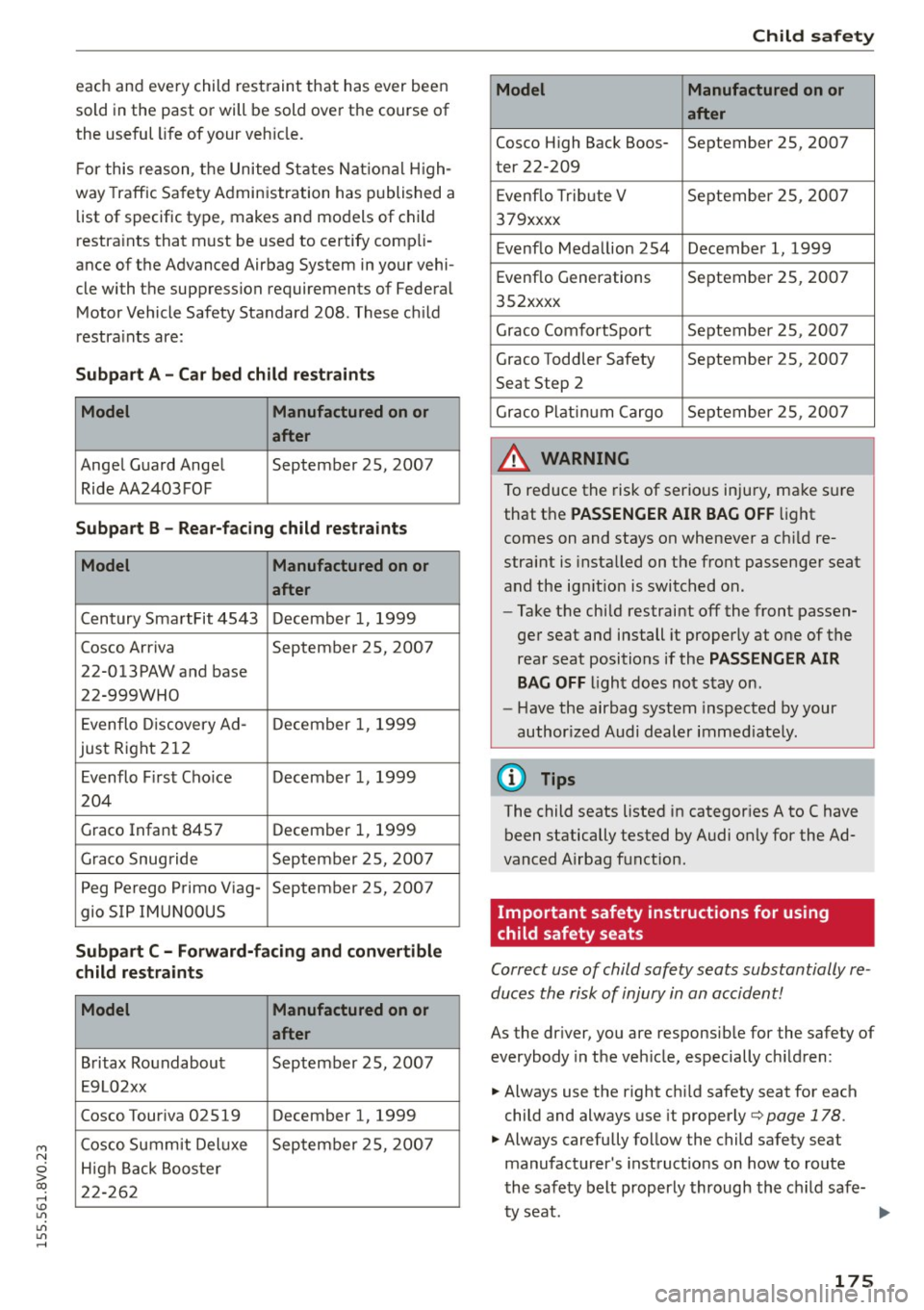
M N
0 > co ,...., \!) 1.1'1
1.1'1
1.1'1
,....,
each and every child rest raint that has ever been
sold in the past or will be sold over the course of
the useful life of your veh icle.
F or this reason, the United States Nat ional H igh
way Traffic Sa fety Admin istration has published a
list of specific type, makes and models of child
restra ints that must be used to certify compli
ance of the Advanced Airbag System in your vehi
cle with the suppression requirements of Federal
Motor Vehicle Safety Standard 208. These chi ld
restra ints are:
Subpart A - C ar bed child restraints
Model Manufactured on or
after
Angel Guard Ange l September 25, 2007
Ride AA2403FOF
Subp art B -Rear-facing child restraints
Model Manufactured on or
after
Century SmartFit 4543 December 1, 1999
C osco Arriva
September 25, 2007
22-013PAW and base
22-999WHO
E venflo D iscovery Ad-December 1, 1999
just Right 2 12
Evenflo F irst Cho ice December 1, 1999
204
Grace Infant 8457 December 1, 1999
Grace Snugride September 25, 2007
Peg Perego Primo V iag-
September 25, 2007
gio SIP IMUNOOUS
Subpart C - Forward-facing and conv ertible
child restraints
Model Manufactured on or
after
B ritax Roundabout Sept ember 25, 2007
E 9 L0 2xx
Cosco Touriva 02519 December 1, 1999
Cosco Summit Deluxe September 25, 2007
H igh Back Booster
2 2-262
Child sa fety
Model Manufactured on or
after
Cosco High Back Boos- September 25, 2007
ter 22-209
E venflo Trib ute V September 25, 200 7
379xxxx
Evenflo Meda llion 254 Decembe r 1, 1999
Evenflo Generations September 25, 2007
352xxxx
Graco ComfortSport September 25, 2007
Grace Toddler Safety September 25, 2007
Seat Step 2
Gr aco Plati num Cargo September 25, 200 7
A WARNING
To reduce the risk of serio us injury, make s ure
that the
PASSENGER AIR BAG OFF li ght
comes on and stays on whenever a ch ild re
straint is installed on the front passenger seat
and the ign it ion is switched on.
- Ta ke the chi ld restraint off the front passen
ger seat and install it properly at one of the
rea r seat positions if the
PASSENG ER AIR
BAG OFF ligh t does not stay on.
- Have the airbag system inspected by your
author ized Audi dealer immed iate ly.
(D Tips
The child seats listed in categor ies A to C have
been statically tested by Audi only for the Ad
vanced Airbag function.
Important safety instructions for using
child safety seats
Correct use of child safety seats substantially re
duces the risk of injury in an accident!
As the driver, you are responsible for the safety of
everybody in t he veh icle, especially ch ildren:
.. Always use the right child safety seat for each
child and always use it properly
¢ page 178 .
.. Always carefully follow the child safety seat
manufacturer's instruct ions on how to route
the safety belt properly through the c hild safe-
t y seat. .,,.
175
Page 179 of 282
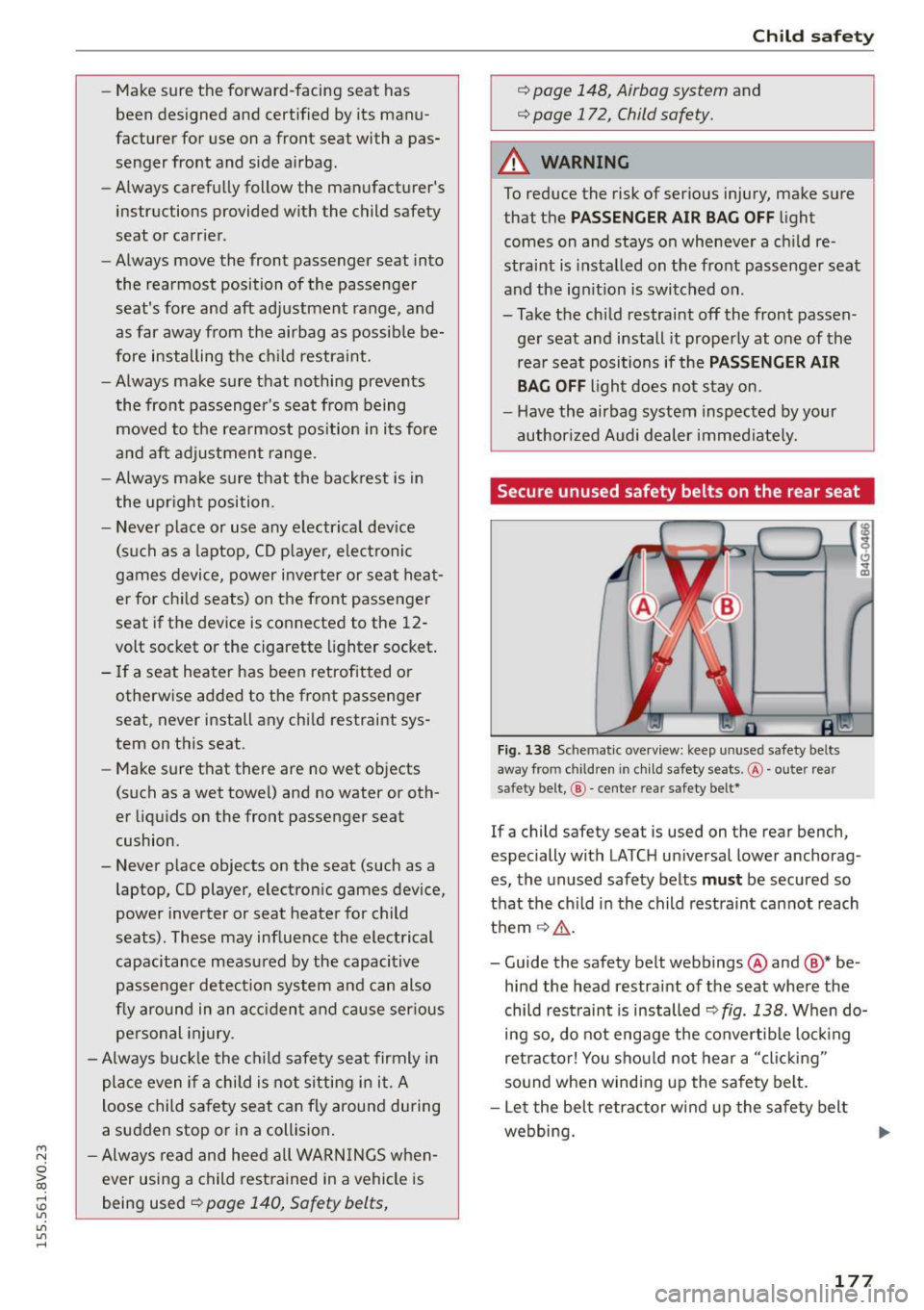
....,
N
0 > co
rl I.O
"'
"'
"'
rl
-Make sure the forward-facing seat has
been designed and certified by its manu
facturer for use on a front seat with a pas
senger front and side airbag.
- Always carefully follow the manufacturer's
instructions provided with the child safety
seat or carrier.
- Always move the front passenger seat into
the rearmost position of the passenger
seat's fore and aft adjustment range, and
as far away from the airbag as possible be
fore installing the child restraint.
- Always make sure that nothing prevents
the front passenger's seat from being
moved to the rearmost position in its fore
and aft adjustment range .
- Always make sure that the backrest is in
the upright position.
- Never place or use any electrical device
(such as a laptop, CD player, electronic
games device, power inverter or seat heat
er for child seats) on the front passenger
seat if the device is connected to the 12-
volt socket or the cigarette lighter socket.
- If a seat heater has been retrofitted or
otherwise added to the front passenger
seat, never install any child restraint sys
tem on this seat.
- Make sure that there are no wet objects
(such as a wet towel) and no water or oth
er liquids on the front passenger seat
cushion.
- Never place objects on the seat (such as a
laptop, CD player, electronic games device,
power inverter or seat heater for child
seats). These may influence the electrical
capacitance measured by the capacitive
passenger detection system and can also
fly around in an accident and cause serious
personal injury.
- Always buckle the child safety seat firmly in
place even if a child is not sitting in it. A
loose child safety seat can fly around during
a sudden stop or in a collision .
- Always read and heed all WARNINGS when
ever using a child restrained in a vehicle is
being used
¢ page 140, Safety belts,
Child safety
¢ page 148, Airbag system and
¢ page 172, Child safety.
A WARNING
-
To reduce the risk of serious injury, make sure
that the
PASSENGER AIR BAG OFF light
comes on and stays on whenever a child re
straint is installed on the front passenger seat
and the ignition is switched on.
- Take the child restraint off the front passen ger seat and install it properly at one of the
rear seat positions if the
PASSENGER AIR
BAG OFF
light does not stay on.
- Have the airbag system inspected by your
authorized Audi dealer immediately.
Secure unused safety belts on the rear seat
Fig. 138 Schematic overview: keep unused safety belts
away from children in c hild safety seats. @-outer rear
safety belt, @ -ce nter rear safety belt*
If a child safety seat is used on the rear bench,
especially with LATCH universal lower anchorag
es, the unused safety belts
must be secured so
that the child in the child restraint cannot reach
them ¢_& .
- Guide the safety belt webbings @and
®* be
hind the head restraint of the seat where the
child restraint is installed
¢ fig. 138. When do
ing so, do not engage the convertible locking
retractor! You should not hear a "clicking "
sound when winding up the safety belt.
- Let the belt retractor wind up the safety belt
webbing.
177